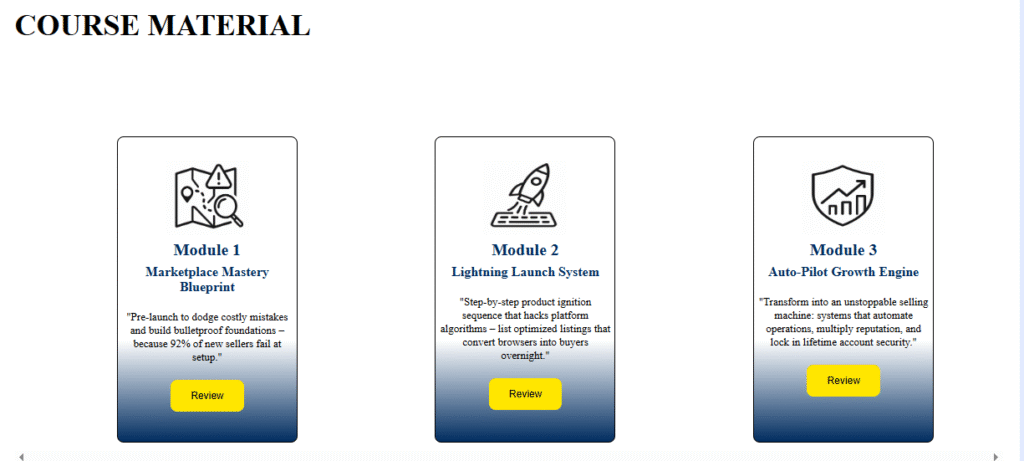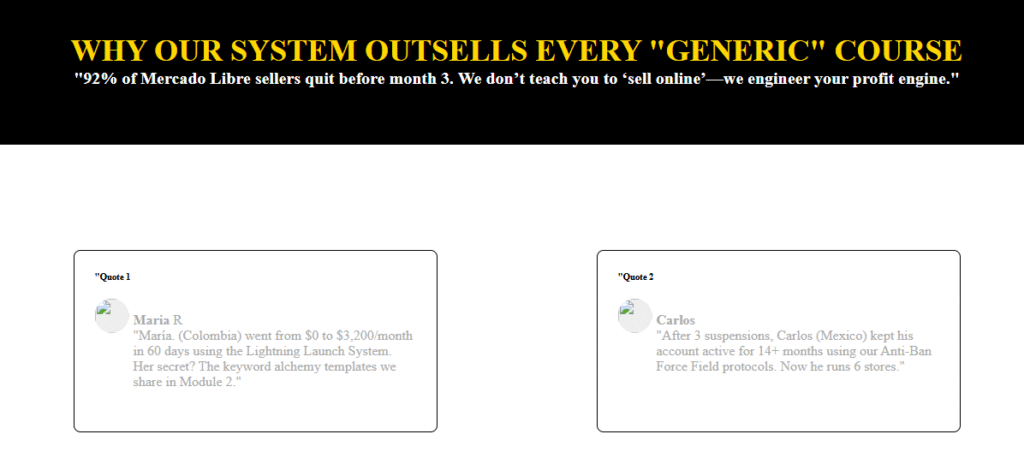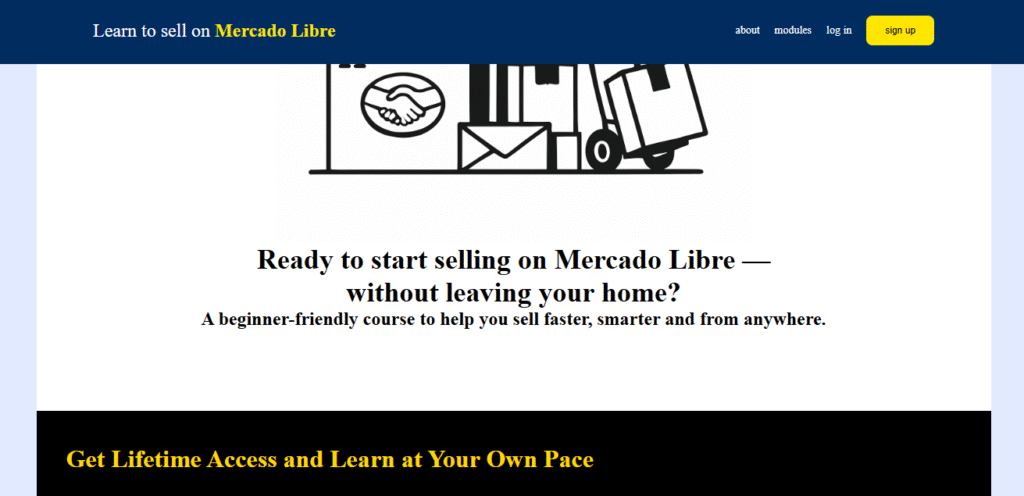Marketing Campaign – Case Study
This case study documents the creation and execution of a digital campaign for an online course titled “How to Sell on Mercado Libre.” The project included measurable goal setting, landing page design and copywriting, SEO strategy implementation, analytics setup, and the development of an email marketing nurture sequence. The campaign was structured in pre-launch, launch, and post-campaign phases, successfully simulating the expected results for portfolio presentation.
1. Goals & numeric targets (measurable)
-
Primary goal (sales):
Sell 10 courses in 2 weeks.
-
Secondary goal (leads):
Capture 200 leads in those 2 weeks.
Traffic estimate:
Assuming an opt-in rate (visitor → lead) of 8%, you need:
Visitors needed = 200 / 0.08 = 2,500 visitors in 2 weeks.
Alternative conservative scenario:
- If lead→sale is 3% → need ~333 leads → visitors ≈ 4,163.
2.Target Audience
Primary Audience:
-
Aspiring sellers who want to start selling on Mercado Libre, especially those with physical products.
-
Existing sellers looking to optimize their strategy and boost sales.
Development of a basic customer journey to pinpoint pain points:
- Stage 1: Lack of knowledge on how to open an account and create listings.
- Stage 2: Difficulty making their product stand out from the competition.
- Stage 3: Lack of confidence in shipping and payment processes.
Audience Research
Analyzed Facebook groups and Mercado Libre forums to identify common pain points.
Monitored LinkedIn/YouTube discussions to map recurring questions (e.g., “How to rank products?”).
3. Timeline (concrete dates)
-
Pre-launch (setup) — Jul 9–10, 2025 (2 days)
-
Finish landing (copy + CTAs), set up GA4 & Search Console, configure email provider (MailerLite/Mailchimp), create discount form and UTM parameter strategy.
-
-
Launch & active campaign — Jul 11 → Jul 24, 2025 (14 days)
-
Week 1 (Jul 11–17): Content push — capture first 80–120 leads.
-
Week 2 (Jul 18–24): Email nurturing, live Q&A, last-chance offers, showcase testimonials (marked as examples).
-
-
Post-campaign analysis — Jul 25–27, 2025
-
Review metrics, generate the portfolio report (simulated), lessons learned, next steps.
-
4. Channels & tactics (organic)
Core channels (organic only):
-
Landing page (central hub).
-
Email marketing — capture emails and run a 3-message nurture flow (Welcome → Value → Offer).
-
Social media: Reels/Shorts (Instagram, TikTok, YouTube Shorts) with micro-tutorials and example testimonials; posts in Facebook groups and seller communities.
-
SEO / blog: One SEO-optimized article “How to start selling on Mercado Libre — beginner’s guide” to capture search traffic over time.
Tactical plan (organic):
-
Publish 3 content pieces/week: 1 short video (Reel), 1 educational post, 1 story with CTA.
-
Share in 5 relevant groups and communities with value-first posts (no spam).
-
Run 1 live Q&A during week 2 to drive urgency and conversions.
-
Offer immediate discount for email signups (e.g., 20% for first 50 signups).
5. Landing page strategy
SEO approach:
Logo text includes the main keyword “Learn to Sell on Mercado Libre” for semantic relevance.
Navigation menu uses short, clear labels for better UX and accessibility.
Image named descriptively (e.g.,
mercado-libre-beginner-course.jpg) with keyword-rich alt text.Proper use of H1 and H2 tags optimized for search queries like “Mercado Libre course” and “how to sell on Mercado Libre.”
Benefits + Price

Goal: Show perceived value and justify investment, and lead to the first CTA.
Key elements: 3–5 measurable benefits, $29 price highlighted, “30-Day Guarantee” badge.
- SEO approach:
Benefits formatted in an unordered list (ul/li) for better scannability and on-page SEO.
Incorporation of secondary keywords related to e-learning and online training.
Modules (3 cards)

Goal: Present course structure clearly.
Key elements: Three cards with title, brief description, and icon.
Image:
modulos-curso-ml.jpg— alt:"Course modules for selling on Mercado Libre".
- SEO approach:
Each image includes descriptive alt text with relevant keywords.
Semantic HTML structure (section/article) improves indexability.
Why Our System and Testimonials

- Goal: Differentiate the methodology, build trust, reduce objections and reinforce trust.
- Key elements: 2 testimonials with real verified photos.
- Recommended copy:
(Primary) “Real Stories, Real Results”
“Our Students Are Already Selling”
“From Zero Sales to a Profitable Business”
“They Trusted Us — You Can Too”
- SEO approach:
Data and statistics presented as HTML text (not only in images) for indexation.
Copy integrates terms like “how to sell on Mercado Libre” and “practical course.”
Potential for
Reviewschema markup in a real implementation to enable rich snippets.
Final CTA with Form

Goal: Capture lead or close the sale.
Key elements: Simple form (name, email), acceptance checkbox, ID
cta-final.
- SEO approach:
Accessible form fields with proper labeling.
Persuasive copy including secondary keywords such as “Mercado Libre course” and “start selling online.”
SEO Strategies Applied Across the Landing Page
- Primary keywords: “Mercado Libre course,” “sell on Mercado Libre,” “start selling online.”
- Optimized images with descriptive filenames and alt text.
- Semantic HTML structure for better indexing.
- Persuasive meta description to boost click-through rates from search results.
- Clear heading hierarchy (H1 → H2 → H3) for both SEO and readability.
6. Channels & tactics (organic)
Core channels (organic only):
Landing page (central hub).
Email marketing — capture emails and run a 3-message nurture flow (Welcome → Value → Offer).
Social media: Reels/Shorts (Instagram, TikTok, YouTube Shorts) with micro-tutorials and example testimonials; posts in Facebook groups and seller communities.
SEO / blog: One SEO-optimized article “How to start selling on Mercado Libre — beginner’s guide” to capture search traffic over time.
Tactical plan (organic):
Publish 3 content pieces/week: 1 short video (Reel), 1 educational post, 1 story with CTA.
Share in 5 relevant groups and communities with value-first posts (no spam).
Run 1 live Q&A during week 2 to drive urgency and conversions.
Offer immediate discount for email signups (e.g., 20% for first 50 signups).
7. Key metrics (KPIs) — what to track & formulas
Visitors (V) — unique visits to the landing page.
Leads (L) — captured emails (discount signups).
Sales (S) — course purchases.
Opt-in rate (%) = (L / V) × 100.
Lead→sale rate (%) = (S / L) × 100.
Landing conversion (sale) = (S / V) × 100.
CTR of CTAs, avg. time on page, bounce rate.
Revenue = S × $29.
CAC (organic) = time × hourly rate (if you want to show non-ad costs).
